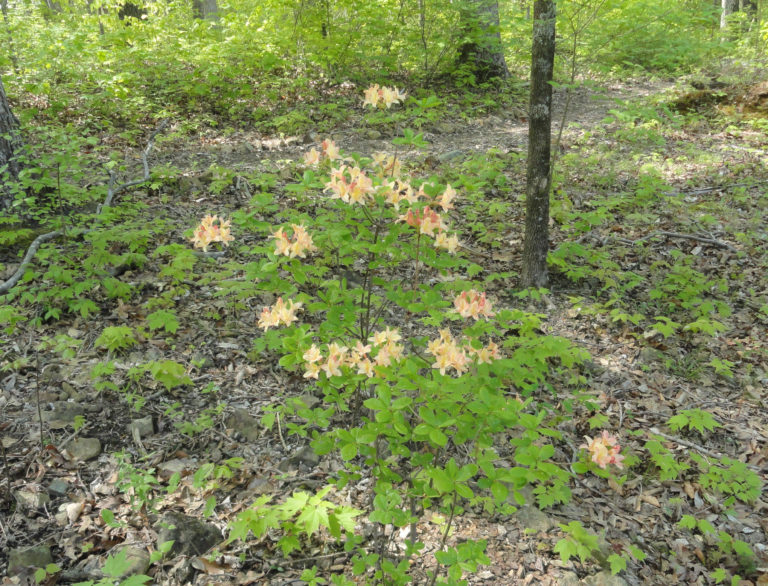Dwarf Coastal Azalea, one of the smaller native azaleas at about 6 feet (with more exposure to light, usually on the order of 4 feet), occurs in sand hill and coastal communities from southern New Jersey to Georgia. It is adorned in spring (April, May) with clusters of wonderfully aromatic, funnel-shaped flowers, with gracefully exserted stamens, usually bright white with pink accents, emerging before or with the leaves. R. atlanticum is a hardy, colonial shrub, preferring well drained, lighter soils and partial shade. In heavier soils it spreads less aggressively. Its shorter stature than other native azaleas makes this a very manageable plant for woodlines, foundation plantings, or garden edges. It often hybridizes or intergrades in the wild with R. periclymenoides in the north and R. canescens in the south. The blooms of R. atlanticum are similar to, although larger than those of Swamp Azalea (R. viscosum), but these latter open after the leaves emerge, from late May through June. R atlanticum was the winner of the 2016 Rhododendron of the Year award (Mid-Atlantic region American Rhododendron Society). R. atlanticum is much used in breeding programs.
NURSERY HOURS
Wednesday: 10-4 Thursday: 10-6 Friday-Saturday: 10-4 Sunday: 12-4
Rhododendron atlanticum

Key Info
Scientific Name: Rhododendron atlanticum (Ashe) Rehder
Common Names: Dwarf Coastal Azalea, Dwarf Azalea
Family Names: Ericaceae (Heath Family)
Plant Type: Tree / Shrub
Leaf Retention: Deciduous
Flower Color: White often with pink
Special Characteristics: Flowers fragrant, Attracts bees, Attracts butterflies, Attracts Hummingbirds, Attracts birds, Rhizomatous
Additional Info
Habit: Somewhat short-lived flowering shrub, loosely-branched, stoloniferous, suckering more in sandy soils.
Height: 3' - 6'
Spread: 3' -6'
Soil Conditions: Moist, light, well drained, acidic, sandy, sandy loams, humusy loams, clay.
Leaves: Alternate, elliptic to obovate, simple, glaucus, bluish-green leaves to 2 1/2” long with smooth or bristly margins, blunt to rounded tips and hairy midrib.
Flowers (or reproductive structures: White flowers to 1 3⁄4” long, sometimes flushed with pink, that bloom in clusters of 3-13 in April at the time of or slightly before the appearance of new leaves. The corolla is covered with sticky glands. The narrow throat expands to 5 petals; its 5 stamens protrude well beyond the corolla mouth. There is a strong musky fragrance. It has repeat blooms in later summer.
Fruit: Many seeds in small, oval, brown pods.
Natural Distribution: Moist, flat, pine woods,; coastal savannas.
USDA Hardiness Zone: 5 to 9A
USDA Wetland Indicator Status in NC: FAC
Pollination: Long-tongue bees, butterflies, other insects; hummingbirds.
Wildlife Connections: Attracts birds, large numbers of bumble bees and other bees, and butterflies. Is not immune to deer browse.
Propagation: Propagated by seeds or by division, root or stem cuttings.
